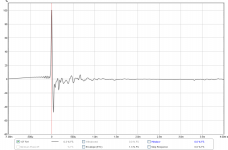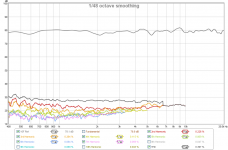It's got a ~7db rise at 5kHz which makes it sound overly bright. A similar rise at >10kHz is much less subjectively objectionable.But when you look a A the IR isn't bad and decent frequency response
10F Reference
Just so you can see what the 10F/8424 looks like when measured in the 10F Ref Monitor which uses a triangular pyramidal "Dagger" backside enclosure for 10F, here are the corresponding IR and HD plots.
Impulse Response:
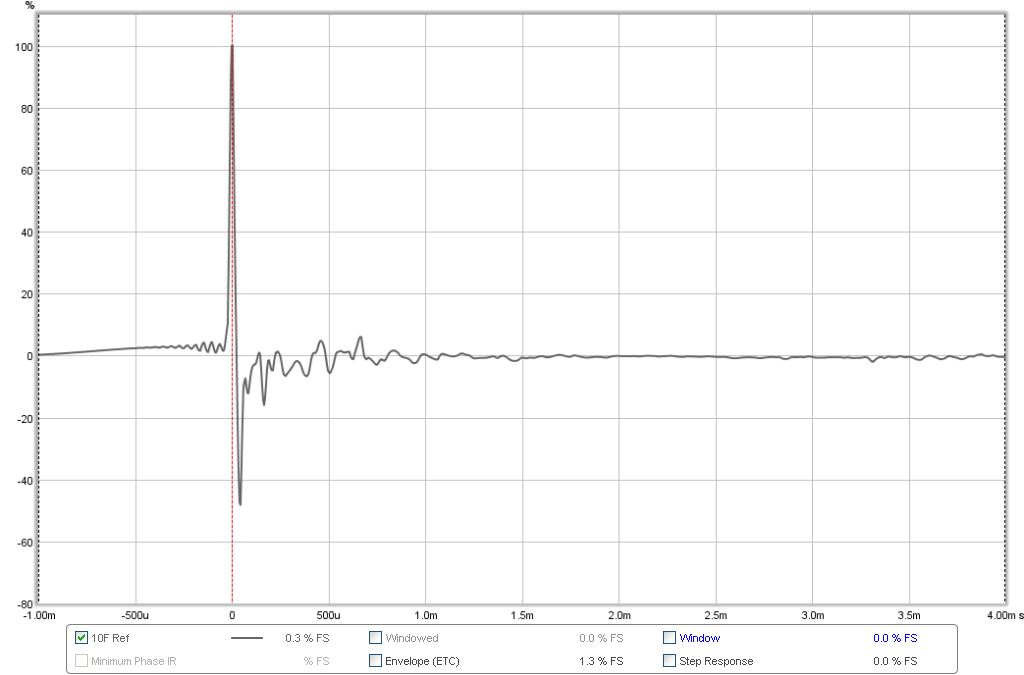
Harmonic Distortion:
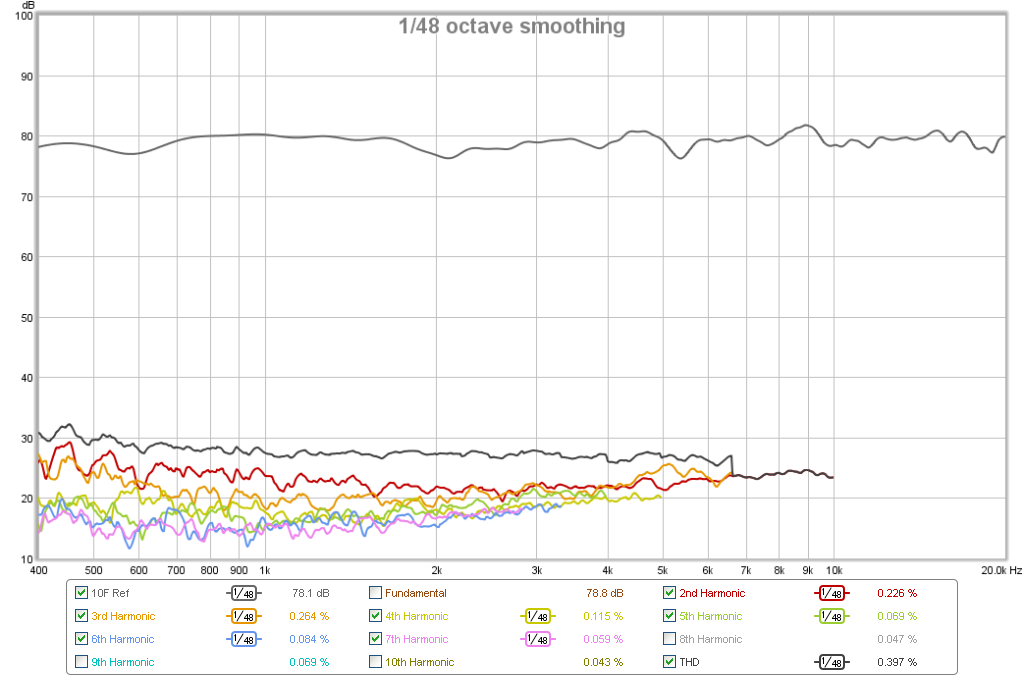
Just so you can see what the 10F/8424 looks like when measured in the 10F Ref Monitor which uses a triangular pyramidal "Dagger" backside enclosure for 10F, here are the corresponding IR and HD plots.
Impulse Response:

Harmonic Distortion:

Attachments
I think I don't believe the THD charts, I mean, all drivers look similar here. In reality, small difference can make or break.
HD plots as I said, were measured at a very low 1.4 volt drive level - which will mean drivers are hardly stressed. For real comparisons, a higher level of stress, typically equivalent to 90dB at 1m will be required for the good drivers to really shine and the mediocre drivers to fall apart on the HD front.
I just did not have time to measure the HD at high drive levels.
I'm actually rather impressed by the performance of the FRS5X (A), though the THD is marginally higher across the band than the others, there are no real peaks to speak of (like C & D) or a rising THD like E, despite their overall level being lower. Absence of THD peaks at the LF end of their usable range is a bonus for the FRS5X and the others (excluding C&D, and maybe E).
Do you mean it's measured performance? I don't understand why you like this driver. I have a pair and I don't even want to waste my time using them.
HD plots as I said, were measured at a very low 1.4 volt drive level - which will mean drivers are hardly stressed. For real comparisons, a higher level of stress, typically equivalent to 90dB at 1m will be required for the good drivers to really shine and the mediocre drivers to fall apart on the HD front.
I just did not have time to measure the HD at high drive levels.
I see. That explained it, then...
Do you mean it's measured performance? I don't understand why you like this driver. I have a pair and I don't even want to waste my time using them.
Because the response is not the same as published.
A couple of things could be causes:
Inaccuracy of published data
Damaged unit POSSIBILITY ( cheap frames easily bent by hand, easy to do this and cause gross THD )
As far as THD goes, its mean level is still lower than the THD peaks of C or D.
E is pretty much a no go for full range use IMHO due to rising THD curves.
Why do I like it? Better bang for buck and performance than C, cloth surround and easy to passive filter put the rising HF (according to datasheet).
The 10F I still the best, should you have the funds to buy them (they should be amazing for the price)
😀
All that being said,the little SB impressed me totally. How its price/performance ratio stacks against the 10F I don't know, but id love to find out.
Last edited:
Mondogen,
You raise a good point about the possibility of damage. The driver was supplied to me as a bonus by Peter Brorsson who also provided the B80. It does indeed have a slightly dented bezel, and as Bart Simpson would say, "It was that way when I got it" 🙂. It looks superficial but who knows - maybe something is indeed amiss so perhaps not fair to the FRS5X to be compared in this instance. If someone wants to send me another unit I will gladly test it and post sound clips.
You raise a good point about the possibility of damage. The driver was supplied to me as a bonus by Peter Brorsson who also provided the B80. It does indeed have a slightly dented bezel, and as Bart Simpson would say, "It was that way when I got it" 🙂. It looks superficial but who knows - maybe something is indeed amiss so perhaps not fair to the FRS5X to be compared in this instance. If someone wants to send me another unit I will gladly test it and post sound clips.
the graphs published by manufacturers are probably based on preliminary measurements of a small sample size of pre production units which may or may not measure the same as the ones you purchase, plus you have to do the measurements under the same conditions as they measure (temp, humidity etc)
Arthur
Arthur
I think it would be interesting to know X's preference knowing that he can listen to them directly 🙂
Mondogen,
You raise a good point about the possibility of damage. The driver was supplied to me as a bonus by Peter Brorsson who also provided the B80. It does indeed have a slightly dented bezel, and as Bart Simpson would say, "It was that way when I got it" 🙂. It looks superficial but who knows - maybe something is indeed amiss so perhaps not fair to the FRS5X to be compared in this instance. If someone wants to send me another unit I will gladly test it and post sound clips.
I think.its still.an outside chance, but its possible. I bought 6 of them, the packaging is minimal unlike most of Visaton products I've bought, but one of the 6 was audibly distorted and the frame was slightly bent.
I think it would be interesting to know X's preference knowing that he can listen to them directly 🙂
Agreed 😀
I think it would be interesting to know X's preference knowing that he can listen to them directly 🙂

To my ears, most drivers seemed to have some serious faults. The least serious was H.
I find the discussion interesting in identifying "ringing" in the impulse response as a serious fault. This is helping my understanding that there is more to the speaker sound than the frequency response.
A big thanks to X for putting this on.
I would like to suggest a better quality recording of the classical music clip. Although, I am a classical listener, I did not find this recording helpful in comparing the speakers.
In the first series of tests, I did not know Nora's voice, so I tried to judge the sound from the piano. Finding more about her on the internet, it seems she uses an electric piano. I was looking for it to sound like a concert grand, and got very confused.
I find the discussion interesting in identifying "ringing" in the impulse response as a serious fault. This is helping my understanding that there is more to the speaker sound than the frequency response.
A big thanks to X for putting this on.
I would like to suggest a better quality recording of the classical music clip. Although, I am a classical listener, I did not find this recording helpful in comparing the speakers.
In the first series of tests, I did not know Nora's voice, so I tried to judge the sound from the piano. Finding more about her on the internet, it seems she uses an electric piano. I was looking for it to sound like a concert grand, and got very confused.
I think it would be interesting to know X's preference knowing that he can listen to them directly 🙂
I was trying to keep my objective distance and to not persuade people from voting one way or another.
If you read my earlier comments, I had a real hard time with this round once I weeded out the initial 4 which audibly did not sound good to my ears - fatiguing and lacking certain ranges.
I was down to B, D, F, H as final four. It took many many sessions to remove F.
Now with B, D, H I tried the listen quickly to just one track (clip 2) and make a decision. I think I could have been happy with anyone of these, and B was a front runner but I picked H for what I perceived as better transient dynamics. Although B had a very nice mid range that was almost fluid-like. D was also good but had a bit too much sizzle.
I find the discussion interesting in identifying "ringing" in the impulse response as a serious fault. This is helping my understanding that there is more to the speaker sound than the frequency response.
A big thanks to X for putting this on.
You are welcome!
The Frequency Response (FR) and Impulse Response (IR) are actually inextricably linked via the Fourier transform. In many measurement systems, the native or raw data is the IR (time domain) and performing a fast Fourier transform (FFT) on the IR gets the FR. Some systems measure the FR and use the inverse FFT to get the IR. Once you are familiar with the transforms, you will see that any ripple or glitch in the FR has to show up as some sort of additional time component in the IR. A larger peak in the FR automatically causes a "ringing" in the IR. A perfectly flat FR produces a perfect single pulse IR with little pre- and post- peak small amplitude ringing that looks like a Bessel function.
For example, here is a perfect frequency response from a speaker that Barleywater made using the TC9FD and a woofer in a FAST and some digital signal processing:
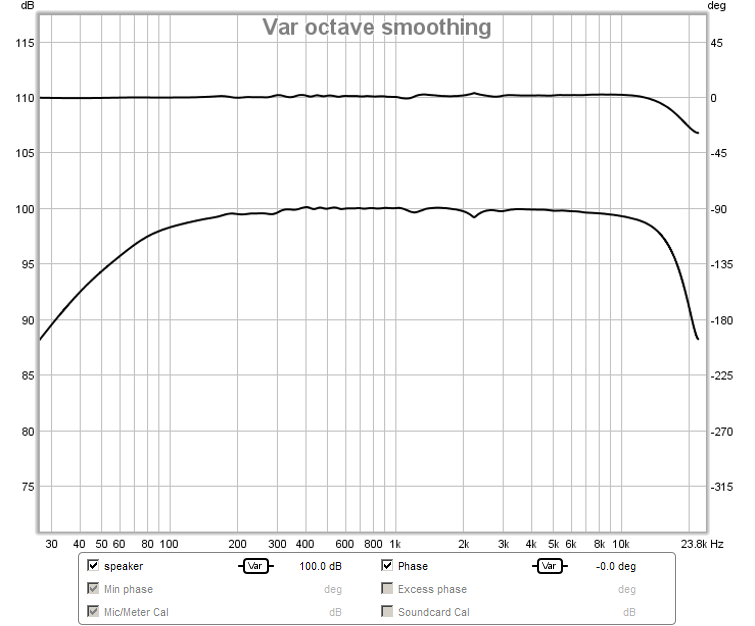
Here is the corresponding IR for a perfectly flat FR:
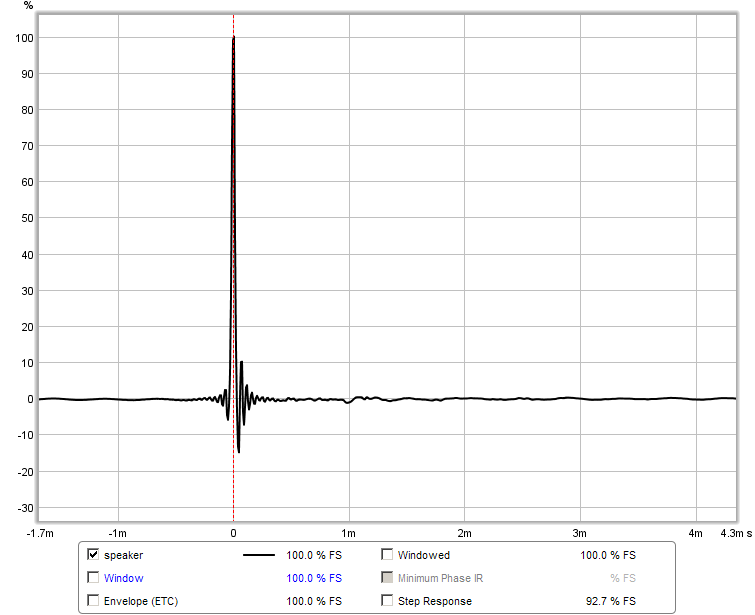
Pretty impressive what one can do with a FAST and some DSP magic...
More on that in this thread: http://www.diyaudio.com/forums/full-range/276349-fast-tc9fd-dsp-performace-testing-platform.html
xrk971 beautifully example of perfect acoustic/electric/DSP treatment for TC9FD by Barleywater linked, can't stop wonder what level of magic he could bring 10F/8424 or SB65WBAC25-4 and their out of box inherent extended HF bandwidth.
xrk971 10F/8424 measurement from post 242 http://www.diyaudio.com/forums/full...2in-4in-drivers-round-3-a-25.html#post4419076.
 .....
.....

xrk971 SB65WBAC25-4 measurement from post 232/231 http://www.diyaudio.com/forums/full...2in-4in-drivers-round-3-a-24.html#post4418888.
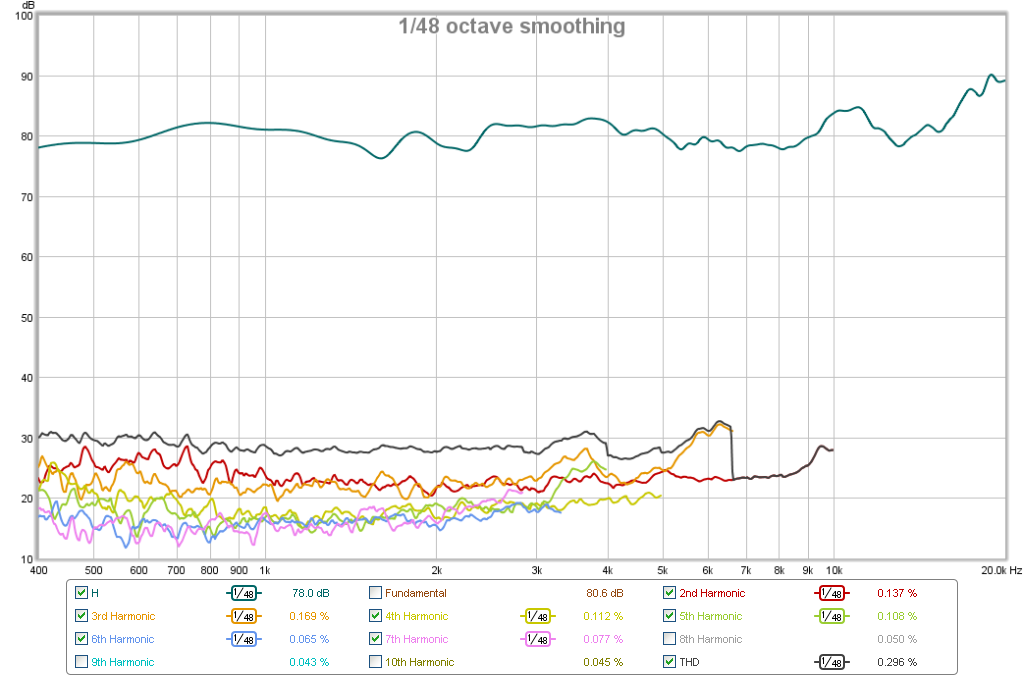 .....
.....
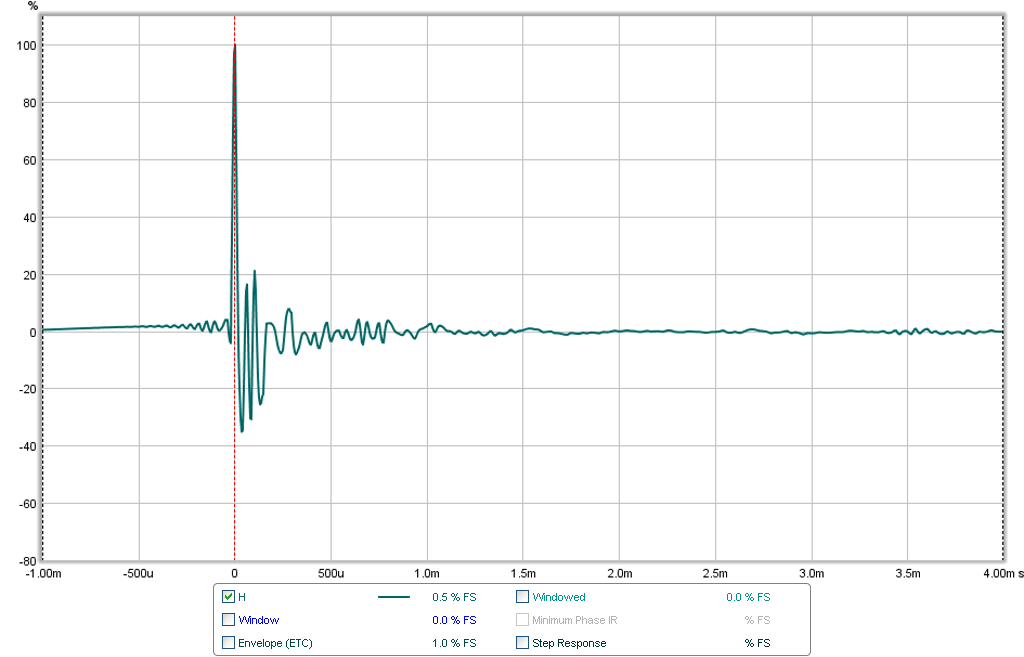
xrk971 10F/8424 measurement from post 242 http://www.diyaudio.com/forums/full...2in-4in-drivers-round-3-a-25.html#post4419076.


xrk971 SB65WBAC25-4 measurement from post 232/231 http://www.diyaudio.com/forums/full...2in-4in-drivers-round-3-a-24.html#post4418888.


Last edited:
Indeed the FRS5X was damaged by me when I was handling them. The surround was visibly distorted when pressing slightly on the cone. Also the response look different from both HobbyHifi and Klang+Ton. I now have more of these so I could send a "healthy" one.
Anyway, I voted for F because of the slightly recessed mids. Normally I fix this area in my DSP so no surprise I liked this driver most. Almost all other drivers were too forward for me in the vocal range.
Btw, it's quite funny to see the comments of drivers when they are revealed🙄
Peter
Anyway, I voted for F because of the slightly recessed mids. Normally I fix this area in my DSP so no surprise I liked this driver most. Almost all other drivers were too forward for me in the vocal range.
Btw, it's quite funny to see the comments of drivers when they are revealed🙄
Peter
I also find it interesting the comments after the reveal, how drivers like D (peerless 830983) was many people's favorite, pick yet H (sb65) got so nearly half the votes, yet everyone now is taking how wonderful the sb65 should be and how bad the 830983 is (bad distortion peaks, FR notches...).
I have read many times and experienced myself, that narrow FR notches (drops) are difficult to hear and unobtrusive, but any sort of peaks (narrow or broad) are very noticeable and distracting. I am not saying that the 830983 is the best here, but I really think it deserves some respect for ranking #2 and measuring well and not be dismissed and putdown because it is a cheap plastic framed 2" peerless.
I just wish peerless drivers were easier and cheaper to attain in Tokyo.
my short list of drivers I want to get next are all peerless: tc9, tg9, 830983, ne65.
Sent from my iPhone using Tapatalk
I have read many times and experienced myself, that narrow FR notches (drops) are difficult to hear and unobtrusive, but any sort of peaks (narrow or broad) are very noticeable and distracting. I am not saying that the 830983 is the best here, but I really think it deserves some respect for ranking #2 and measuring well and not be dismissed and putdown because it is a cheap plastic framed 2" peerless.
I just wish peerless drivers were easier and cheaper to attain in Tokyo.
my short list of drivers I want to get next are all peerless: tc9, tg9, 830983, ne65.
Sent from my iPhone using Tapatalk
I also find it interesting the comments after the reveal, how drivers like D (peerless 830983) was many people's favorite, pick yet H (sb65) got so nearly half the votes, yet everyone now is taking how wonderful the sb65 should be and how bad the 830983 is (bad distortion peaks, FR notches...).
Hehehe, haven't I mentioned this before the reveal 🙂 I think Peerless is just a great speaker manufacturer (a manufacturer with great speaker engineers).
peterbrorsson and jeshi,
You right it can be fun or interesting comments after reveal. A guess could be some reason is because when measurement data are revealed too some can see that if they do some tricks as example acoustic/electric/DSP treatment a lower ranked driver can be improved. As example my own ranking B/D/F/H would not change if I had to run the drivers response untreated out of box, but if acoustic/electric/DSP steering is used then revealed measured data from H makes it look as a good chance to get a high performer is my thought.
You right it can be fun or interesting comments after reveal. A guess could be some reason is because when measurement data are revealed too some can see that if they do some tricks as example acoustic/electric/DSP treatment a lower ranked driver can be improved. As example my own ranking B/D/F/H would not change if I had to run the drivers response untreated out of box, but if acoustic/electric/DSP steering is used then revealed measured data from H makes it look as a good chance to get a high performer is my thought.
some can see that if they do some tricks as example acoustic/electric/DSP treatment a lower ranked driver can be improved.
Actually we cannot avoid the fact that we will always include "subjective" criteria and judgement, meaning that it never be 100% by the sound alone.
And this can be a problem. For example, when we listen to driver C and we assume that it is an SBAcoustic, then we can accept C because we think we can notch the 20kHz peak of the SBA! 🙄
It was hard for me to choose D as my preference, ONLY after I heard clip6 of Mariah Carey. In this song B clearly outperformed D, and D's problem was clearly exposed. And I made a wrong judgement that this problem could be caused by the Harsch crossover, so I thought that with better implementation that problem will be solved. But after the frequency response was revealed, it is clear that what I heard was the issue with the wiggled response below 1kHz, not the crossover ?
But this problem I believe can be solved by modifying either one or more of (1) smaller surround, may be with more damping (2) smaller dust cap, or none at all (3) inverted curve on top of the original cone with dust cap removed (4) additional ND magnet strips to increase flux.
The Visaton OTOH, I'm not impressed at all, even tho in my note it is objectively the best. I think Mondo and others have mentioned why they don't like this driver, and I think I more or less have similar reason. Tho extra ND magnet may fix one of the weakness.
- Status
- Not open for further replies.
- Home
- Loudspeakers
- Full Range
- A Subjective Blind Comparison of 2in to 4in drivers - Round 3
